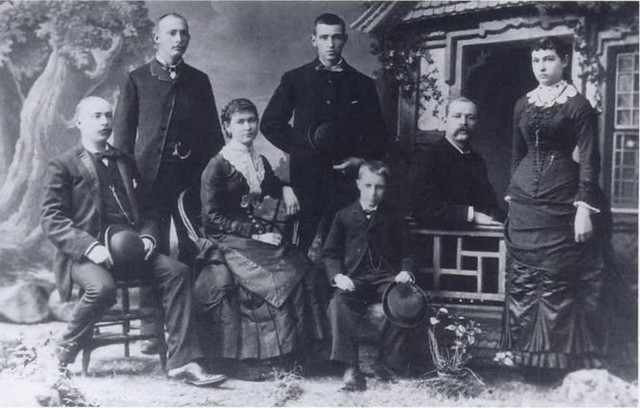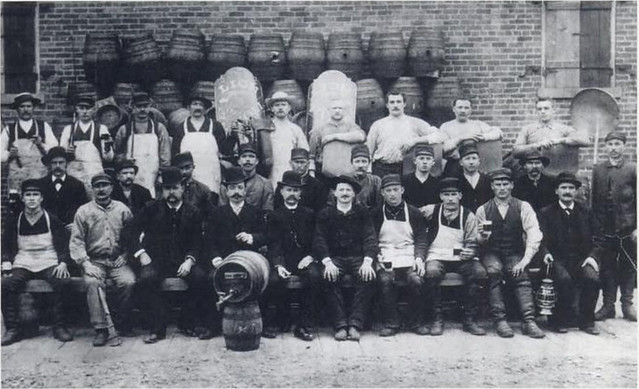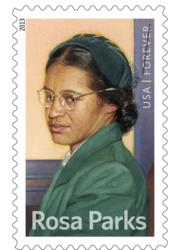On February 3, 1838, passengers rode the Michigan Central Railroad for the first time, from Detroit to Ypsilanti. Eventually, it would expand to connect many more exotic places like Niagara Falls!
 Michigan Central Railroad (red) and New York Central system (orange) as of 1918
Michigan Central Railroad (red) and New York Central system (orange) as of 1918
Michigan Central Railroad (Battle Creek Depot Station) opened on July 27, 1888.
Sources :
Detroit Historical Society Facebook Page
Michigan Central Railroad wikipedia entry
Michigan Central Railroad : History of the Main Line 1846-1901 available through MelCat and Interlibrary Loan : In pioneer America, the Michigan Central Railroad (MCRR) became the major route between east and west, linking older states and their restless populations to young cities like Detroit and Chicago, and to the wide open spaces beyond. Now, for the first time in book form, historian Nick Marsh systematically relates the colorful story of this legendary enterprise, drawing on numerous archival records, photographs, and artifacts. The MCRR story is a story of toil, triumph, and tragedy. Marsh includes chapters on the railroad’s construction, its conversion from a state-owned to a private enterprise, the sad ending to a Michigan farmers’ rebellion, the involvement of William H. Vanderbilt, and the empire building of the visionary James F. Joy. Eagerly anticipated by many, the appearance of Marsh’s comprehensive account will bring joy to legions of rail fans, history buffs, and connoisseurs of Americana.
Railroads for Michigan / Graydon M. Meints.
Bill Loomis, “Riding the first rails brought excitement, danger”, Detroit News, July 8, 2012.
Today is the birthday of Julius Stroh (February 3, 1856-June 2, 1939). He was born in Michigan, the son of Bernard Stroh, who founded the Stroh Brewery in Detroit, Michigan in 1850. After his father died, his brother Bernard Jr. took over the brewery, but in 1908 he assumed control of the family brewery.

Julius Stroh in 1933, pouring the first glass of beer after Michigan repealed prohibition.
Given the time he was at the helm of the Stroh Brewery, there’s surprisingly little biographical information or images of him.

The Stroh family around 1871, with Julius on the far left.
This is what Wikipedia has to say about Stroh’s early days through Julius Stroh’s tenure:
The Stroh family began brewing beer in a family-owned inn during the 18th century in Kirn, Germany. In 1849, during the German Revolution, Bernhard Stroh (1822-1882), who had learned the brewing trade from his father, emigrated to the United States. Bernhard Stroh established his brewery in Detroit in 1850 when he was 28 and immediately started producing Bohemian-style pilsner, which had been developed at the municipal brewery of Pilsen, Bohemia in 1842. In 1865, he purchased additional land and expanded his business and adopted the heraldic lion emblem from the Kyrburg Castle in Germany and named his operation the Lion’s Head Brewery. (The lion emblem is still visible in its advertising and product labels.)
Bernhard Stroh’s original beer selling operation consisted of a basement brewing operation and was then sold door-to-door in a wheelbarrow. The new beer (Stroh’s) sold door-to-door was a lighter-lager beer, brewed in copper kettles.
The Stroh Brewery around 1864.Bernhard Stroh Jr. took charge of the brewery on the death of his father. He changed the brewery’s name to the B. Stroh Brewing Company. With the introduction of pasteurization and refrigerated rail cars, Stroh was able to ship some of his beer as far as Florida and Massachusetts. In 1893 Stroh Bohemian Beer won a blue ribbon at the Columbian Exposition in Chicago. The company’s name was changed to The Stroh Brewery Company in 1902. In 1908, Bernhard Stroh’s brother Julius Stroh took over the brewery. After a tour of famous European breweries, he introduced the European fire-brewing method in the Stroh brewery. Common in Europe before World War I, the fire-brewing process uses a direct flame rather than steam to heat beer-filled copper kettles. The company claims that the resulting higher temperatures bring out more of the beer’s flavor.
During Prohibition, Julius Stroh operated the business under the name The Stroh Products Company, producing near beer (beer with its alcohol extracted), birch beer, soft drinks, malt products, ice cream, and ice. Though production of most of these items ceased when Prohibition ended in 1933, a special unit of the brewery continued to make Stroh’s Ice Cream (this facility remained in Detroit until February 2007, when the operation was moved to Belvidere, Illinois, though the distribution facility in Detroit still remains).
Upon Julius Stroh’s death in 1939, his son Gari Stroh assumed the presidency.

Stroh employees around 1885, with Julius Stroh sitting behind the barrel.
Sources:
Jay Brooks, “Historic Beer Birthday: Julius Stroh“, Brookston Beer Bulletin, February 3, 2018.
Brewed in Detroit: Breweries and Beers Since 1830, Volume 1. Peter Blum. Detroit : Wayne State University Press, [1999]
On February 3, 1889, the ten-story Hammond Building became Detroit’s first skyscraper. Located at West Fort and Griswold Streets, the building was demolished in 1956 and replaced by the new headquarters for the National Bank of Detroit, which is now known as The Qube.
When the Hammond opened, “Detroit was astir with excitement over the completion of its first skyscraper,” William Hawkins Ferry wrote. To celebrate, tightrope walker Tommy Davenport was hired to walk across Fort Street, a dizzying 10 stories up.
“I remember when the Hammond Building was the eighth wonder of the world as a skyscraper and a tight-rope walker walked from the City Hall tower to the new Hammond Building. Our tonsils were sunburnt for days after,” Detroit News editor Malcolm W. Bingay wrote in 1935.
On Aug. 31, 1890, the Free Press reported that every window of the Hammond was illuminated, creating a “pillar of light” and a “splendid sight” for throngs of onlookers, both common Detroiters and visitors to that year’s Detroit International Exposition. “The 246 offices and the stores on the ground floor have been brightly lighted up with Edison incandescent lights and gas every night during the past week to give exposition visitors an opportunity of viewing the magnitude of the building after dark,” the Free Press wrote. The building was open during the day and evening to allow Expo visitors to climb to the top for “a splendid bird’s-eye view of the city.”
Detroiters “clamored for an opportunity to climb to the roof and look over the sprawling city,” the Free Press wrote in 1938. “Up-state communities, arranging for excursions to this metropolis, began to advertise the unprecedented opportunities for a bird’s-eye view of Detroit from the roof of the Hammond Building.” Such excitement, festivities and awe made the Hammond a beloved landmark to Detroiters for decades.
The Hammond’s height led to it becoming the headquarters of the local weather bureau. Captains of freighters headed up the Detroit River would look to the Hammond’s roof, where flags during the day and oil lanterns by night signaled storm conditions on the Great Lakes. The building’s main floor was used for stores and bank offices, and the rest was office space, which housed some of Detroit’s most influential movers and shakers, from the Joys to the Newberrys to the McMillans. The Detroit Tigers had an office in the Hammond, and fans would look up to its roof to see whether a white flag with a blue circle was flying: That was the signal that the Tigers were playing that day at Bennett Park, which was located on the site of Tiger Stadium before the beloved ballpark was constructed.
Sources:
Michigan Historical Society Page (February 3 entry)
Dan Austin, Hammond Building, HistoricDetroit.org
Sydney Harris Howe, no relation to Gordie, joined the Wings in 1935, bought along with another player named Scotty Bowman (no relation to the game’s winningest coach) for $50,000 in a deal that completely surprised Howe.
Howe was one of the league’s leading scorers for a decade. On Feb. 3, 1944, he scored a record 6 goals in one game. The next day The Detroit News detailed the goals, and the wildly happy crowd’s antics. The large crowd of 12,293 — which included 900 school patrol boys — became more frenzied as the double hat trick became more inevitable.
The crowd groaned as Howe shot the puck over the net early in the third period but half a minute later Mud Bruneteau and Grosso set him up again. Howe feinted McAuley. As the latter lunged to the right, Howe flicked the puck right over McAuley into the net.” A grinning Howe left the game on the shoulders of his teammates, to the ecstatic cheers of the spectators.
“They were going in the net tonight — another night they don’t,” Howe said modestly. “I don’t remember any goal in particular. The boys were feeding them to me nicely.
“No celebration for me,” he added, “I’m due at work at 7:10 a.m.”
Howe worked as a machinist at Ford by day. He played center and left wing by night.
In 1945 he became the greatest scorer of all time in the NHL with 558 points (232 goals, 282 assists). Never flashy, just doggedly durable, Howe one of the cleverest players ever to put on skates.
A 1945 profile reads, “All in all, quite a hockey player this Mr. Howe. He might better be styled ‘Wing of all Time’ than to be called ‘Wing of the Week’.”
Sources :
Vivian M. Baulch, “The glorious Wings of old”, Detroit News Blog, February 5, 1999.
On February 3, 1956 highway speed limits of 65 miles per hour by day and 55 by night went into effect in Michigan. Prior to this motorists could determine what was safe and reasonable.
Source : Historical Society of Michigan.
Ninety-year-old John “Jack” Crawford will go down in history with the likes of George Washington, Thomas Edison and Winston Churchill.
Crawford’s exploits fighting in World War II with an elite Special Forces unit – considered the forebear to today’s Special Forces such as the Navy SEALs and Green Berets – were recognized Tuesday, Feb. 3, with a Congressional Gold Medal.
Crawford is among the ranks of World War II’s 1st Special Service Force, an American-Canadian elite commando unit organized in 1942. Participants fought in Italy and France before the unit was disbanded in December 1944.
Not to be confused with the Medal of Honor, the highest award for valor in action given to individuals serving in the U.S. military, the Congressional Gold Medal is the highest civilian honor that Congress bestows.
Crawford, who now lives in Clare County’s Harrison, said he jumped at the opportunity to join an elite fighting unit in 1943 after about a year on assignment in Maryland, where he said the weather was getting “too hot” and he was becoming bored stateside.
Some of Crawford’s unit’s exploits were immortalized in the 1968 movie “The Devil’s Brigade.”
The 1st Special Service Force received the Congressional Gold Medal in Washington D.C. at 3 p.m. Tuesday, Feb. 3. Of the 2,500 men who originally joined the unit, some 130 are still alive. Crawford chose not to attend the ceremony in Washington, instead celebrating in Jackson with family.
Crawford returned stateside in 1945 and married his wife Nina in 1947. The couple lived in and around Jackson for about 40 years before moving to Harrison. They have three children, and are just recently great-great-grandparents.
Sources :
Will Forgrave, “Original member of first-ever Special Forces unit receives Congressional Gold Medal”, MLive, February 4, 2015.
Pat Maurer, “WW II SSF survivors get Congressional Gold Medal – Crawford tells about experiences in Devils’ Brigade”, Clare County Review.

Wayne Terwilliger didn’t waste a single moment of his 95 years.
He was a World War II veteran, serving in combat with the Marines in Sapian, Tinian and Iwo Jima. He attended Western Michigan for three years and followed that with a nine-year Major League Baseball career, where he was once teammates with Jackie Robinson.
He then spent 50-plus years as a minor league manager and MLB coach that saw him work under another all-time great, Ted Williams, and later win two World Series with the Minnesota Twins.
He was also a Charlotte native, the son of Ivan and Doris Terwilliger, a three-sport star at Charlotte High School who graduated in 1942 and spent numerous offseasons back in his hometown, including a short stint running a local bar during his lone year away from coaching.
Source : Phil Friend, “‘Ride of a lifetime’: Wayne Terwilliger, World War II vet, World Series champ, Charlotte native, dies at 95”, Lansing State Journal, February 22, 2021.
On Feb. 4, 1836, a resolution was introduced in the Michigan House asking for the extermination of wolves.
According to the resolution, wolves were “brigands,” preying on wildlife and farm animals at all times, but more ferocious as game became scarcer in January and February.
The resolution went nowhere, apparently due to the general impression that it was impossible to exterminate a wild animal in an area that was three-quarters wild.
Source: History Do You Know? via MIRS, February 4, 2015.

Charles Lindbergh was born February 4, 1902, to Charles and Evangeline Lodge Lindbergh. He was born at an uncle’s house at 1220 W. Forest, in what is now Detroit’s Midtown, but raised in Minnesota.
His mother later moved to Detroit in the 1920s and became a chemistry teacher at Cass Tech High School, and Mayor John C. Lodge — yes, as in the freeway — was his great uncle.
Lindbergh was catapulted to celebrity when he became the first person to fly nonstop across the Atlantic Ocean, flying his plane the Spirit of St. Louis from New York to Paris on May 20-21, 1927. It took him more than 33 hours to make the 3,600-mile trek. The feat earned him the nicknames “Lucky Lindy” and “the Lonely Eagle.”
Ticker-tape parades were held in his honor in New York and St. Louis, he was named Time magazine’s Man of the Year in ’27, and President Calvin Coolidge awarded him the Medal of Honor.
During World War II, he moved to Bloomfield Hills and worked at the Willow Run bomber plant.
For more information about the aviator, visit Wikipedia
Sources :
Michigan Every Day
Dan Austin, “The day Charles Lindbergh was born in Detroit“, Detroit Free Press, February 4, 2015.
Tim Trainor, “Lindbergh, Detroit’s native son, became a sensation“, Detroit News, March 31, 2018; updated April 23, 2018.
George Bulanda, “Charles Lindbergh, 1927”, Hour Detroit, February 24, 2011.

On February 4, 1913, civil rights icon Rosa Parks was born in rural Tuskegee, Alabama.
Born Rosa Louise McCauley, this remarkable woman is remembered as the “mother of the modern day civil rights movement.” Most famously, she gained national attention in 1955 when she refused to give up her seat to a White male on a Montgomery, Alabama city bus. With little more than a high-school education, Rosa Parks inspired a generation of activists to fight legal segregation in the United States.
 Rosa Parks being fingerprinted after being arrested for boycotting public transportation.
Rosa Parks being fingerprinted after being arrested for boycotting public transportation.
Later in life, Parks was bestowed with numerous honorary degrees and national awards, including the NAACP’s esteemed Spingarn Medal and the Presidential Medal of Freedom, presented to her in 1996 by President Bill Clinton.

On June 18, 1997, the Michigan Legislature passed Public Act 28 stating:
(1) The legislature recognizes the outstanding contributions to American life, history, and culture made by Mrs. Rosa L. Parks, a woman of great courage, vision, love, and faith, who for decades has resided in our great state and continues to serve the state of Michigan and her country by actively laboring to achieve equality for all. In commemoration of the significant role Mrs. Rosa L. Parks has played in the history of the state of Michigan and the nation, the legislature declares that the first Monday following February 4 of each year shall be known as “Mrs. Rosa L. Parks day”.
(2) The legislature encourages individuals, educational institutions, and social, community, religious, labor, and business organizations to pause on Mrs. Rosa L. Parks day and reflect upon the significance of Mrs. Rosa L. Parks’s love and important contributions to the history of the state of Michigan and to the history of this great nation. MCL435.111
Rosa Parks was 92 years old when she died in her Detroit home on October 24, 2005. The front seats of city buses in Detroit and Montgomery were adorned with black ribbons in the days preceding her funeral. Fifty thousand people visited her casket as it rested for two days in the Rotunda of the United States Capitol, the first woman to receive this honor. A seven-hour funeral service was held for her at the Greater Grace Temple Church in Detroit, followed by a procession in which thousands of people came to celebrate one of the bravest and most influential figures of the 20th century.
Rosa Parks is buried in Detroit’s Woodlawn cemetery.
 President Obama sitting in the Montgomery, Alabama bus at Dearborn Village where it is now displayed.
President Obama sitting in the Montgomery, Alabama bus at Dearborn Village where it is now displayed.
Today, we celebrate her legacy as a courageous leader and inspiring civil and human rights activist.
For more information visit Biography.com’s Rosa Parks Bio and video
Jeanne Theoharis, The Rebellious Life of Mrs. Rosa Parks, Beacon Press, 2013.
Rosa Parks : my story / by Rosa Parks, with Jim Haskins. New York : Dial Books, c1992.
Todd Spangler, “Rosa Parks papers give insight into the civil rights icon”, Detroit Free Press, February 3, 2015.



